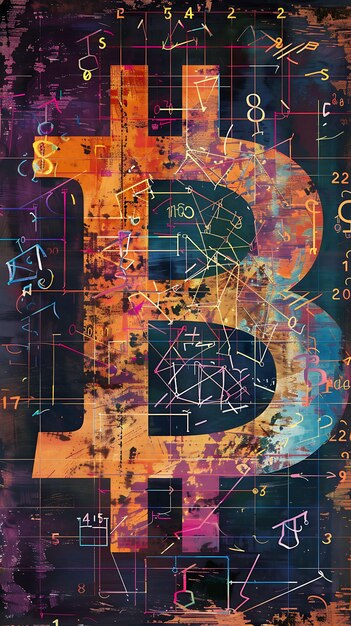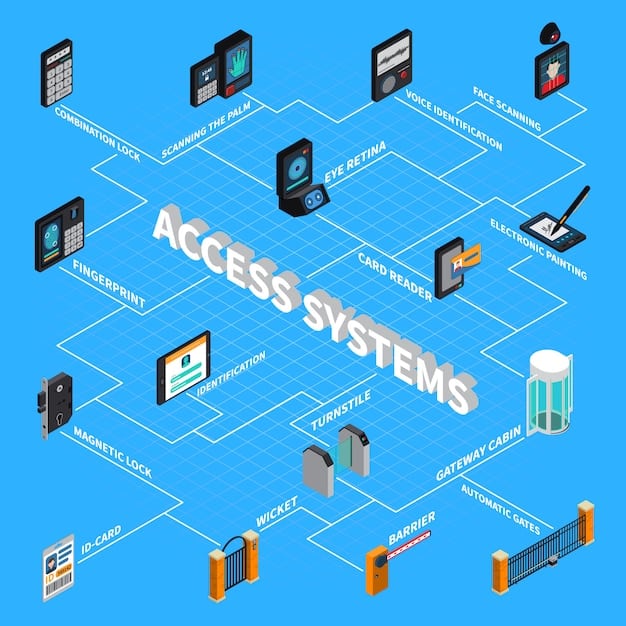Quantum Computing Threats: Cybersecurity Measures to Implement by Q3 2025

Quantum computing’s rapid advancement poses significant threats to current cybersecurity infrastructure, necessitating the implementation of advanced measures such as quantum-resistant algorithms and enhanced key management strategies by Q3 2025 to safeguard sensitive data and systems.
The advent of quantum computing presents a paradigm shift in computational power, bringing both immense opportunities and unprecedented risks to the realm of cybersecurity. The ability of quantum computers to break existing encryption algorithms threatens the security of sensitive data worldwide, making it imperative to address quantum computing threats: What cybersecurity measures must be implemented by Q3 2025?
Understanding the Looming Threat of Quantum Computing
Quantum computing leverages the principles of quantum mechanics to perform complex calculations far beyond the capabilities of classical computers. While still in its nascent stages, the potential impact of quantum computing on cryptography is profound. Current encryption methods, such as RSA and ECC, rely on the computational difficulty of certain mathematical problems. Quantum algorithms, like Shor’s algorithm, can efficiently solve these problems, rendering existing encryption vulnerable.
The threat is not merely theoretical. As quantum computers continue to develop, the timeline for breaking current encryption shortens. Organizations and governments must act now to prepare for a future where existing cryptographic standards are obsolete.
The Implications for Data Security
The implications of quantum computing for data security are far-reaching. Industries that rely heavily on encryption, such as finance, healthcare, and government, are particularly at risk. Secure communication channels, protected databases, and digital signatures all become vulnerable. Imagine a scenario where sensitive financial transactions are decrypted, patient records are exposed, or classified government communications are intercepted. The potential consequences are catastrophic.
Moreover, the risk extends beyond immediate decryption. Data encrypted today could be stored and decrypted later when quantum computers are sufficiently advanced. This ‘harvest now, decrypt later’ scenario necessitates proactive measures to protect data against future threats.
Assessing the Current Cybersecurity Landscape
The current cybersecurity landscape is ill-prepared for the quantum era. Most organizations rely on classical encryption methods and lack the infrastructure to implement quantum-resistant alternatives. This gap highlights the urgent need for awareness, education, and investment in quantum-safe technologies.
- Lack of Awareness: Many organizations are unaware of the imminent threat posed by quantum computing.
- Insufficient Expertise: The cybersecurity workforce lacks the expertise to implement and manage quantum-resistant solutions.
- Outdated Infrastructure: Existing cybersecurity infrastructure is not designed to support quantum-safe technologies.
Addressing these gaps requires a multi-faceted approach, including government initiatives, industry collaboration, and academic research. Only through collective effort can we create a cybersecurity ecosystem that is resilient to quantum threats.
In conclusion, the threat of quantum computing to data security is substantial and growing. Organizations must understand the implications and take proactive measures to protect their data. Assessing the current cybersecurity landscape reveals significant gaps that need to be addressed urgently.
Implementing Quantum-Resistant Cryptography
Quantum-resistant cryptography, also known as post-quantum cryptography (PQC), involves developing cryptographic algorithms that are resistant to attacks from both classical and quantum computers. These algorithms aim to replace existing encryption methods that are vulnerable to quantum attacks. The National Institute of Standards and Technology (NIST) is at the forefront of this effort, leading a standardization process to identify and validate PQC algorithms.
Migrating to PQC is a complex undertaking that requires careful planning, testing, and implementation. Organizations must assess their current cryptographic infrastructure, identify vulnerable systems, and develop a roadmap for transitioning to quantum-resistant solutions.

NIST’s Standardization Efforts
NIST’s standardization process is a critical step in ensuring the widespread adoption of PQC. The agency has been evaluating candidate algorithms through a rigorous testing and analysis process. The goal is to select a set of standardized algorithms that can be widely adopted by industry and government.
The standardization process involves multiple rounds of evaluation, with each round narrowing down the field of candidate algorithms. NIST considers various factors, including security strength, performance, and implementation complexity. The selected algorithms will form the basis of future cryptographic standards.
Key Candidate Algorithms
Several candidate algorithms have emerged as frontrunners in the NIST standardization process. These algorithms fall into different categories, each with its own strengths and weaknesses.
- Lattice-Based Cryptography: Based on the difficulty of solving mathematical problems on lattices.
- Multivariate Cryptography: Relies on the complexity of solving systems of multivariate polynomial equations.
- Hash-Based Cryptography: Uses cryptographic hash functions to provide security.
Each of these algorithms offers different levels of security, performance, and implementation complexity. Organizations must carefully evaluate their requirements and choose the algorithms that best suit their needs.
Challenges and Considerations for Implementation
Implementing PQC is not without its challenges. These challenges include:
Migrating to PQC requires significant effort and resources. Organizations must carefully plan and execute the transition to ensure minimal disruption and maximum security. Investing in education and training is also crucial to ensure that cybersecurity professionals have the skills necessary to manage quantum-resistant systems.
- Performance Overhead: PQC algorithms may have higher computational overhead compared to classical algorithms.
- Key Size: PQC keys may be larger than classical keys, requiring more storage and bandwidth.
- Algorithm Maturity: Some PQC algorithms are still relatively new and lack extensive real-world testing.
In summary, implementing quantum-resistant cryptography is essential for safeguarding data against quantum threats. NIST’s standardization efforts are paving the way for the widespread adoption of PQC. However, organizations must be aware of the challenges and considerations involved in implementing quantum-resistant solutions.
Enhancing Key Management Strategies
Effective key management is crucial for maintaining the security of cryptographic systems. Traditional key management practices are inadequate in the face of quantum threats. Quantum key distribution (QKD) and hybrid approaches offer enhanced security for key exchange and management.
QKD leverages the principles of quantum mechanics to securely distribute encryption keys. It is a fundamentally different approach compared to classical key exchange protocols, such as Diffie-Hellman. QKD offers unconditional security, meaning that the security of the key exchange is guaranteed by the laws of physics, rather than relying on the computational difficulty of mathematical problems.
Quantum Key Distribution (QKD)
QKD works by transmitting photons with quantum properties that can be used to generate a secret key between two parties. Any attempt to eavesdrop on the transmission will inevitably disturb the quantum properties of the photons, alerting the legitimate parties to the presence of an eavesdropper. This allows them to discard the compromised key and establish a new one.
Hybrid Approaches to Key Management
Hybrid approaches to key management combine classical and quantum techniques to achieve enhanced security. These approaches offer a practical and cost-effective way to transition to quantum-resistant cryptography.
- Combining QKD with PQC: Using QKD to distribute keys for PQC algorithms.
- Layered Security: Implementing multiple layers of encryption, including both classical and quantum-resistant algorithms.
- Key Rotation: Regularly rotating encryption keys to limit the impact of a potential compromise.

The Role of Hardware Security Modules (HSMs)
Hardware Security Modules (HSMs) play a critical role in securing cryptographic keys. HSMs are tamper-resistant hardware devices that protect sensitive keys from unauthorized access. They provide a secure environment for generating, storing, and managing cryptographic keys.
In the quantum era, HSMs must be adapted to support PQC algorithms and QKD. This may involve upgrading existing HSMs or deploying new HSMs that are specifically designed to handle quantum-resistant cryptography.
In conclusion, enhancing key management strategies is essential for mitigating quantum threats. QKD offers unprecedented security for key exchange, while hybrid approaches provide a practical path for transitioning to quantum-resistant cryptography. HSMs play a critical role in securing keys and must be adapted to support quantum-safe technologies.
Securing Communication Channels
Secure communication channels are the backbone of modern digital infrastructure. Protecting these channels against quantum attacks requires a comprehensive approach that includes implementing PQC, securing network infrastructure, and educating users.
Implementing PQC in communication protocols, such as TLS/SSL and VPNs, is crucial for ensuring the confidentiality and integrity of data transmitted over these channels. Organizations must upgrade their systems to support quantum-resistant algorithms.
Implementing Quantum-Resistant Protocols
Upgrading communication protocols to support PQC is a complex task that requires careful planning and execution. Organizations must assess their current protocols, identify vulnerable components, and develop a roadmap for transitioning to quantum-resistant alternatives.
Securing Network Infrastructure
Securing network infrastructure is also essential for protecting communication channels against quantum attacks. This includes implementing strong authentication mechanisms, monitoring network traffic for suspicious activity, and patching vulnerabilities.
In addition to technical measures, user education is crucial for maintaining the security of communication channels. Users must be trained to recognize and avoid phishing attacks, malware, and other threats that could compromise their systems.
Educating Users About Quantum Threats
Raising awareness among users about quantum threats is essential for preventing security breaches. Users should be educated about the risks posed by quantum computing and the measures they can take to protect themselves.
- Phishing Attacks: Educate users to recognize phishing attempts.
- Malware: Train users to avoid downloading malicious software.
- Password Security: Encourage strong, unique passwords.
In summary, securing communication channels against quantum threats requires a comprehensive approach that includes implementing PQC, securing network infrastructure, and educating users. By taking these steps, organizations can ensure the confidentiality and integrity of their data in the quantum era.
Developing Quantum-Safe Data Storage Solutions
Data storage solutions must be adapted to protect against quantum attacks. Implementing PQC for data at rest and developing quantum-resistant backups are essential for ensuring the long-term security of stored data.
Implementing PQC for data at rest involves encrypting data stored on hard drives, solid-state drives, and other storage media using quantum-resistant algorithms. This ensures that even if the storage media is compromised, the data remains protected.
Implementing PQC for Data at Rest
Upgrading data storage solutions to support PQC is a complex task that requires careful planning and execution. Organizations must assess their current storage infrastructure, identify vulnerable components, and develop a roadmap for transitioning to quantum-resistant alternatives.
Quantum-Resistant Backups
Developing quantum-resistant backups is also crucial for ensuring the long-term security of stored data. Backups should be encrypted using PQC algorithms and stored in a secure location. Regular testing of backups is essential to ensure that they can be restored in the event of a disaster.
Data Encryption Strategies
Different data encryption strategies can be employed to enhance the security of data storage systems. The right strategy depends on specific needs and the type of data being stored.
- Full-Disk Encryption: Encrypts the entire storage device.
- File-Level Encryption: Encrypts individual files.
- Database Encryption: Encrypts entire databases.
In conclusion, developing quantum-safe data storage solutions is essential for protecting against quantum attacks. Implementing PQC for data at rest and developing quantum-resistant backups are crucial steps in ensuring the long-term security of stored data.
Preparing for Incident Response in a Quantum World
Incident response plans must be updated to address quantum threats. Developing quantum-aware incident response procedures and training incident response teams are essential for effectively responding to quantum-related security incidents.
Developing quantum-aware incident response procedures involves creating specific protocols for handling security incidents that involve quantum attacks. This includes identifying and isolating compromised systems, analyzing the root cause of the incident, and implementing corrective actions.
Developing Quantum-Aware Procedures
Developing quantum-aware incident response procedures requires a deep understanding of quantum threats and the potential impact on security systems. Organizations must invest in education and training to ensure that incident response teams have the skills necessary to handle quantum-related incidents.
Training Incident Response Teams
Training incident response teams is also crucial for ensuring their effectiveness in responding to quantum-related security incidents. This includes providing training on quantum cryptography, quantum attacks, and quantum-safe technologies.
Simulating Quantum Attacks
Conducting simulations of quantum attacks can help incident response teams prepare for real-world incidents. These simulations can identify weaknesses in existing incident response plans and provide valuable training opportunities.
In conclusion, preparing for incident response in a quantum world is essential for mitigating the impact of quantum threats. Developing quantum-aware incident response procedures and training incident response teams are crucial steps in ensuring an effective response to quantum-related security incidents.
Conclusion: The Imperative of Quantum-Safe Security by Q3 2025
As we approach Q3 2025, the urgency of implementing quantum-safe cybersecurity measures cannot be overstated. The threat posed by quantum computing is not a distant future concern but a present-day reality that demands immediate action. Organizations must prioritize the adoption of quantum-resistant cryptography, enhance key management strategies, and secure communication channels and data storage solutions. Preparing incident response plans for a quantum world is also essential. By taking these steps proactively, we can safeguard our digital infrastructure and ensure a secure future in the face of quantum computing threats.
| Key Aspect | Brief Description |
|---|---|
| 🔒 PQC Implementation | Adopting quantum-resistant algorithms to protect against quantum attacks. |
| 🔑 Key Management | Enhancing key security with QKD and hybrid approaches. |
| 🛡️ Secure Channels | Protecting communication through quantum-resistant protocols. |
| 🚨 Incident Response | Updating plans for quantum-aware incident handling. |
FAQ
▼
Quantum computing threats arise from quantum computers’ ability to break current encryption. This compromises data security, affecting finance, healthcare, and government sectors.
▼
Quantum-resistant cryptography (PQC) involves cryptographic algorithms that resist attacks from both classical and quantum computers, ensuring data security in the quantum era.
▼
Effective key management ensures the security of cryptographic systems. Quantum Key Distribution (QKD) and hybrid approaches offer enhanced key exchange and management.
▼
Communication channels can be secured by implementing Quantum-Resistant protocols, securing network infrastructure, and educating users about quantum threats and security measures.
▼
Quantum-safe data storage involves implementing PQC for data at rest and developing quantum-resistant backups to ensure the long-term security of stored data, even against quantum attacks.
Conclusion
The rise of quantum computing necessitates a proactive and comprehensive approach to cybersecurity. By understanding the threats, implementing quantum-resistant measures, and preparing for incident response, organizations can protect their data and infrastructure in the quantum era. The deadline of Q3 2025 serves as a critical checkpoint for achieving quantum-safe security.





